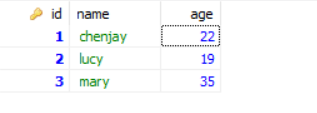版权声明:本文为博主原创文章,欢迎转载,转载请注明作者、原文超链接 ,博主地址:https://blog.csdn.net/mr_chenjie_c。 https://blog.csdn.net/Mr_Chenjie_C/article/details/84874715
Spring支持声明式事务,即使用注解来选择需要使用事务的方法,它使用@Transactional注解在方法上表明该方法需要事务支持。当然,Spring Boot开启事务也只需要一个注解@Transactional 就可以了。
准备阶段
在pom文件中引入mybatis启动依赖:
<dependency>
<groupId>org.mybatis.spring.boot</groupId>
<artifactId>mybatis-spring-boot-starter</artifactId>
<version>1.3.2</version>
</dependency>
引入mysql 依赖
<dependency>
<groupId>mysql</groupId>
<artifactId>mysql-connector-java</artifactId>
<scope>runtime</scope>
</dependency>
<dependency>
<groupId>com.alibaba</groupId>
<artifactId>druid</artifactId>
<version>1.0.29</version>
</dependency>
初始化数据库脚本
-- 导出 springboot_test 的数据库结构
CREATE DATABASE IF NOT EXISTS `springboot_test`
USE `springboot_test`;
-- 导出 表 springboot_test.user 结构
CREATE TABLE IF NOT EXISTS `user` (
`id` int(11) NOT NULL,
`name` varchar(50) COLLATE utf8_bin DEFAULT NULL,
`age` int(3) DEFAULT NULL,
PRIMARY KEY (`id`)
) ENGINE=InnoDB DEFAULT CHARSET=utf8 COLLATE=utf8_bin;
-- 正在导出表 springboot_test.user 的数据:~0 rows (大约)
INSERT INTO `user` (`id`, `name`, `age`) VALUES
(1, 'chenjay', 22),
(2, 'lucy', 19),
(3, 'mary', 35);
配置数据源
spring:
datasource:
type: com.alibaba.druid.pool.DruidDataSource
driver-class-name: com.mysql.jdbc.Driver
url: jdbc:mysql://localhost:3306/springboot_test?useUnicode=true&characterEncoding=UTF-8
username: root
password: root
创建实体类
public class User {
private int id;
private String name;
private int age;
//getter.. setter..
}
dao层
@Mapper
public interface UserDao {
@Update("update user set age = #{age} where id = #{id}")
int update(User user);
@Select("select id, name, age from user where id = #{id}")
User findUser(@Param("id") int id);
}
service层
@Service
public class UserService {
@Autowired
private UserDao userDao;
@Transactional
public void rollback() throws Exception {
User user = userDao.findUser(1);
ddAge(user);
User user1 = userDao.findUser(3);
ddAge(user1);
userDao.update(user);
int i = 1 / 0;
userDao.update(user1);
}
public void withoutRollback() throws Exception {
User user = userDao.findUser(1);
ddAge(user);
User user1 = userDao.findUser(3);
ddAge(user1);
userDao.update(user);
int i = 1 / 0;
userDao.update(user1);
}
private void ddAge(User user) {
user.setAge(user.getAge() + 1);
}
}
Controller层
@RestController
@RequestMapping("/user")
public class UserController {
@Autowired
private UserService userService;
@GetMapping(value = "/rollback")
public String rollback() {
try {
userService.rollback();
} catch (Exception e) {
e.printStackTrace();
}
return "rollback";
}
@GetMapping(value = "/withoutRollback")
public String withoutRollback() {
try {
userService.withoutRollback();
} catch (Exception e) {
e.printStackTrace();
}
return "withoutRollback";
}
}
运行测试
- 回滚测试
此时查看数据库数据是否有变化
可以从上图看出数据库数据没有发生改变,说明 rollback方法遇到异常之后回滚了数据。
- 不回滚测试
此时查看数据库数据是否有变化
可以从上图看出数据库数据没有发生改变,说明 withoutRollback方法遇到异常之后没有回滚数据。
总结
Spring Boot 开启事物很简单,只需要加一行注解就可以了,前提你用的是JdbcTemplate, JPA, MyBatis等这些常见的orm框架。



